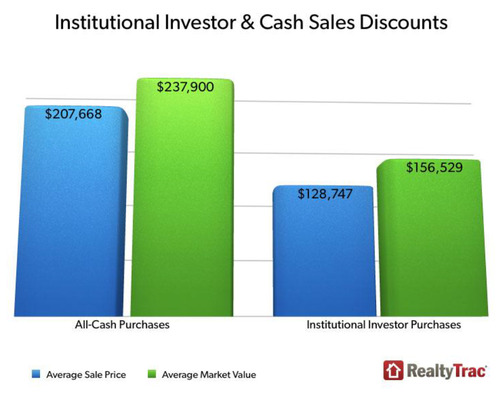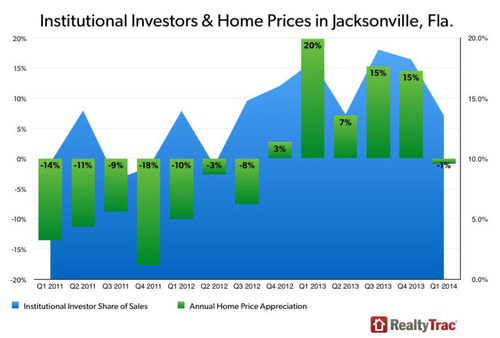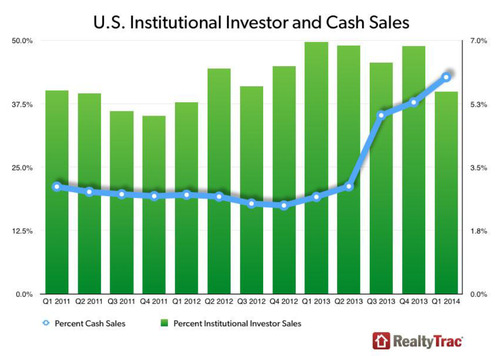The WPJ
THE WORLD PROPERTY JOURNALReal Estate Facts Not Fiction
Residential Real Estate News

All-Cash Buyers Reach Record High in U.S.
Residential News » North America Residential News Edition | By Michael Gerrity | May 8, 2014 1:15 AM ET
Cash has becoming king in the U.S. housing market these days, according to a new report released this week by RealtyTrac.
Based on RealtyTrac's new U.S. Institutional Investor & Cash Sales Report for Q1, 2014, the share of all-cash sales reached a new high in the first quarter even as the share of institutional investor purchases dropped to the lowest level since the first quarter of 2012.
 The report shows 42.7 percent of all U.S. residential property sales in the first quarter were all-cash purchases, up from 37.8 percent in the previous quarter and up from 19.1 percent in the first quarter of 2013 to the highest level since RealtyTrac began tracking all-cash purchases in the first quarter of 2011.
The report shows 42.7 percent of all U.S. residential property sales in the first quarter were all-cash purchases, up from 37.8 percent in the previous quarter and up from 19.1 percent in the first quarter of 2013 to the highest level since RealtyTrac began tracking all-cash purchases in the first quarter of 2011.Institutional investors -- entities that have purchased at least 10 properties in a calendar year -- accounted for 5.6 percent of all U.S. residential sales in the first quarter, down from 6.8 percent in the fourth quarter of 2013 and down from 7.0 percent in the first quarter of 2013 to the lowest level since the first quarter of 2012.
"Strict lending standards combined with low inventory continue to give the advantage to investors and other cash buyers in this housing market," said Daren Blomquist, vice president at RealtyTrac. "The good news is that as institutional investors pull back their purchasing in many markets across the country, there is still strong demand from other cash buyers -- including individual investors, second-home buyers and even owner-occupant buyers -- to fill the vacuum of demand left by institutional investors.
"While the institutional investor purchase share declined in the first quarter in 18 of the top 20 markets for institutional investor share a year ago, home prices continued to appreciate in most of those markets, albeit at a slower pace in many cases," Blomquist continued. "There are a couple notable exceptions that could be cause for concern: Jacksonville, Fla., where the institutional investor share of purchases was down to 13.5 percent in the first quarter compared to 18 percent a year ago and where median home prices decreased 1 percent from a year ago in March after 15 consecutive months of annual increases; and Greensboro, N.C., where the institutional investor of purchases was down to 6.4 percent in the first quarter compared to 10 percent a year ago and where median home prices decreased 8 percent from a year ago in March following 14 of 16 months were median home prices increased annually."
Cash sales more than half of all sales in Miami, New York, Detroit, Atlanta and Las Vegas
Among metropolitan statistical areas with a population of at least 500,000, those with the top five highest percentages of cash sales were all in Florida: Cape Coral-Fort Myers, (73.6 percent), Miami (67.1 percent), Sarasota, (65.1 percent), Palm Bay, (64.1 percent), and Lakeland, (61.8 percent).
 Other major metro areas with more than 50 percent all-cash sales included New York (57.0 percent), Columbia, S.C., (56.1 percent), Memphis (54.9 percent), Detroit (53.5 percent), Atlanta (53.2 percent) and Las Vegas (52.2 percent).
Other major metro areas with more than 50 percent all-cash sales included New York (57.0 percent), Columbia, S.C., (56.1 percent), Memphis (54.9 percent), Detroit (53.5 percent), Atlanta (53.2 percent) and Las Vegas (52.2 percent)."The cash buyer segment of the Northern Nevada housing market is very strong. More than 50 percent of transactions in our Reno office were cash sales. High-end home sales are strong as well, and we typically see a higher percentage of those buyers purchase with cash," said Craig King, COO of Chase International, covering the Lake Tahoe and Reno, Nev., markets. "As the level of inventory dwindles in the price points sought after by investors, so do the number of investor sales. We continue to see a strong interest from investors, but the inventory to support the demand just isn't there."
"The Ohio housing market is experiencing low available inventory, which has created heightened competition amongst investors positioning for investment purchases on an institutional and individual basis," said Michael Mahon, executive vice president/broker at HER Realtors, covering the Cincinnati, Columbus and Dayton, Ohio, markets. "Due to this heightened competition, we have equally noticed an increase in cash sales during the first quarter of 2014, as a negotiation tactic in capturing inventory on more advantageous pricing terms. Institutional investors maintained their active roles in purchasing Ohio housing inventory, contributing to increases in equity and property values across the state."
Other high-level findings from cash purchases data:
- 15 percent of all-cash purchases in the first quarter were properties in the foreclosure process, and 10 percent were bank-owned properties.
- 11 percent of all-cash purchases in the first quarter were to institutional investors, investors buying at least 10 properties in a calendar year.
- 52 percent of all-cash purchases in March (most recent month's data only available for this metric) were sold to buyers with a different mailing address than the property address -- indicating investors or second-home buyers. That compares to 34 percent of all sales -- cash and financed -- sold to investors or second-home buyers in March.
- The average sales price of an all-cash purchase in the first quarter was $207,668 -- 13 percent below the average estimated full market value of the properties that were purchased: $237,900.
Institutional investor share up in San Francisco, Dallas, Miami, Atlanta and Las Vegas
Among metropolitan statistical areas with a population of at least 500,000, those with the biggest annual increase in share of institutional investor purchases were Baton Rouge, La., (up 131 percent), San Francisco (up 92 percent), McAllen, Texas (up 62 percent), Allentown, Pa., (up 49 percent), and Omaha, Neb., (up 49 percent).
 Other major metro areas with an annual increase in the share of institutional investor purchases included Dallas-Fort Worth (up 45 percent), Miami (up 8 percent), Atlanta (up 38 percent), Minneapolis (up 8 percent), Tampa (up 17 percent), San Antonio (up 25 percent), and Las Vegas (up 24 percent).
Other major metro areas with an annual increase in the share of institutional investor purchases included Dallas-Fort Worth (up 45 percent), Miami (up 8 percent), Atlanta (up 38 percent), Minneapolis (up 8 percent), Tampa (up 17 percent), San Antonio (up 25 percent), and Las Vegas (up 24 percent).Major metro areas with an annual decrease in the share of institutional investor purchases included New York (down 44 percent), Los Angeles (down 80 percent), Chicago (down 41 percent), Washington, D.C. (down 52 percent) and Phoenix (down 14 percent).
"Institutional investors have bought up much of the affordable inventory they are traditionally interested in, which explains the decrease in institutional investor sales," said Chris Pollinger, senior vice president of sales at First Team Real Estate, covering the Southern California market. "We are seeing a rise in foreign buyers purchasing high-end homes, which is contributing to the rise in all-cash purchases.
"Inventory shortages as well as lending regulations favor the all-cash buyer, which explains the increase in cash sales on both a national and local level," Pollinger added.
"There just aren't as many listings to satisfy the demands of institutional investors in the Oklahoma market. REO Listing inventory is down 50% in Oklahoma City from a year ago and down 20% in Tulsa," said Sheldon Detrick, CEO of Prudential Detrick/Alliance Realty, covering the Oklahoma City and Tulsa, Okla. markets. "So you have more investors chasing a much smaller pie; resulting in multiple offers and higher sales prices."
Other high-level findings from institutional investor data:
- 84 percent of all institutional investor purchases were all-cash purchases in the first quarter.
- 35 percent of institutional investor purchases were properties built in 2000 or later, and 50 percent were built in 1990 or later.
- 30 percent of all institutional investor purchases were properties in the foreclosure process, and 15 percent were bank-owned properties.
- The average sales price of institutional investor purchases in the first quarter was $128,747 -- 18 percent below the average "after repair" estimated market value of the homes being purchased: $156,529.
Sign Up Free | The WPJ Weekly Newsletter
Relevant real estate news.
Actionable market intelligence.
Right to your inbox every week.
Real Estate Listings Showcase
Related News Stories
Residential Real Estate Headlines
- More Americans Opting for Renting Over Homeownership in 2024
- BLOCKTITLE Global Property Tokenization Platform Announced
- Small Investors Quietly Reshaping the U.S. Housing Market in Late 2024
- Greater Miami Overall Residential Sales Dip 9 Percent in November
- U.S. Home Sales Enjoy Largest Annual Increase in 3 Years Post Presidential Election
- U.S. Housing Industry Reacts to the Federal Reserve's Late 2024 Rate Cut
- U.S. Home Builders Express Optimism for 2025
- Older Americans More Likely to Buy Disaster-Prone Homes
- NAR's 10 Top U.S. Housing Markets for 2025 Revealed
- U.S. Mortgage Delinquencies Continue to Rise in September
- U.S. Mortgage Rates Tick Down in Early December
- Post Trump Election, U.S. Homebuyer Sentiment Hits 3-Year High in November
- Global Listings Aims to Become the Future 'Amazon of Real Estate' Shopping Platform
- Greater Las Vegas Home Sales Jump 15 Percent in November
- Ultra Luxury Home Sales Globally Experience Slowdown in Q3
- World Property Exchange Announces Development Plan
- Hong Kong Housing Market to Reach Equilibrium in Late 2025
- Construction Job Openings in U.S. Down 40 Percent Annually in October
- U.S. Mortgage Applications Increase in Late October
- World Property Markets, World Property Media to Commence Industry Joint-Venture Funding Rounds in 2025
- New Home Sales Hit 2 Year Low in America
- U.S. Pending Home Sales Increase for Third Consecutive Month in October
- Pandemic-led Residential Rent Boom is Now Fizzling in the U.S.
- Emerging Global Real Estate Streamer WPC TV Expands Video Programming Lineup
- 1 in 5 Renters in America Entire Paycheck Used to Pay Monthly Rent in 2024
- U.S. Home Sales Jump 3.4 Percent in October
- Home Buyers Negotiation Power Grows Amid Cooling U.S. Market
- Canadian Home Sales Surge in October, Reaching a Two-Year High
- Greater Orlando Area Home Sales Continue to Slide in October
- U.S. Mortgage Credit Availability Increased in October
- U.S. Mortgage Rates Remain Stubbornly High Post Election, Rate Cuts
- Construction Input Prices Continue to Rise in October
- BETTER MLS: A New Agent and Broker Owned National Listings Platform Announced
- Home Prices Rise in 87 Percent of U.S. Metros in Q3
- Caribbean Islands Enjoying a New Era of Luxury Property Developments
- The World's First 'Global Listings Service' Announced
- Agent Commission Rates Continue to Slip Post NAR Settlement
- Market Share of First Time Home Buyers Hit Historic Low in U.S.
- Greater Palm Beach Area Residential Sales Drop 20 Percent Annually in September
- Mortgage Applications in U.S. Dip in Late October
Reader Poll
Marketplace Links
This website uses cookies to improve user experience. By using our website you consent in accordance with our Cookie Policy. Read More





